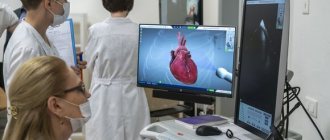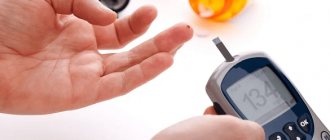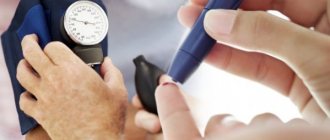- Photometric instruments.
- Electrochemical devices.
- Spectrometric glucometers.
Based on the determination of glucose levels in accordance with the measurement of the color of the reagent. Depending on the amount of sugar in the blood, the color of the reagent applied to the test strip changes. The optical system built into the glucometer evaluates the color intensity, determining the amount of glucose based on this indicator. This measurement method is considered inaccurate and is currently practically not used.
The measurement is also based on the reagent applied to the test strip. When a drop of blood containing glucose touches the reagent, a chemical reaction occurs that stimulates the accumulation of electrical potential. Based on the strength of this potential, the device determines the concentration of sugar in the blood. Almost all modern blood glucose meters operate on the electrochemical principle. A more advanced subtype of the electrochemical measurement method is coulometry. The process is based on determining the total electronic charge that is released as a result of the interaction of a drop of blood with a reagent on a test strip. The main advantage of coulometry is the minimum amount of blood required for analysis.
This is an improved type of device that works non-invasively, that is, a drop of blood is not required for analysis. The measurement is carried out using a laser, which selects the glucose spectrum from all spectra. To date, this technology is considered unfinished. During the analysis process, glucometers make many mistakes, producing low-accuracy results.
Content:
- What is a glucometer and how it works?
- How to properly set up a glucometer?
- How to use a glucometer correctly?
- Short description
Any disorders of carbohydrate metabolism, including diabetes mellitus type 1 or 2, require monitoring of blood glucose levels. For this purpose, a glucometer is used. How to use the strips and the device itself, and calibrate it to obtain reliable results is indicated in the instructions. In general, most devices have similarities in the principle of glucose determination and use.
What is total sugar control?
To know how the body reacts to the prescribed diet and medications, you need to conduct careful self-monitoring of sugar concentration. Therefore, the device often takes measurements, namely:
- immediately after sleep;
- before breakfast;
- 5 hours after insulin injection;
- always before meals;
- after any meal after 2 hours;
- before sleep;
- before and after physical labor;
- after stress;
- if you suspect that your sugar has changed;
- in the middle of the night.
All numbers are entered into a notebook. This helps figure out what is causing the sugar spikes.
Clear interface
What is a glucometer and how it works?
A glucometer is a device that is used to determine the level of glucose in the blood. All modern instruments carry out measurements based on 3 operating principles:
- Photometry
– the concentration of glucose is determined by the strength of the color change of the reagent after contact with blood.
- Biosensory measurement
– blood is applied to the strip, glucose reacts with a certain compound, which leads to a change in the electrical potential, which is recorded by the device.
- Electrochemical determination (coulometry)
– analysis of glucose concentration is carried out by calculating the total charge of electrons after the blood reacts with certain compounds.
To obtain a reliable result, it is important to use the glucometer correctly. The instructions for use contain all the information about the stages of determining blood glucose, as well as calibrating the device.
How to properly set up a glucometer?
Each device must be configured correctly before first use. In almost all glucometers, regardless of the operating principle and manufacturer, the basic settings include the following parameters:
- date and time
.
- OSD language.
- Sugar units
(in most cases the measurement is set in units of mmol/l).
- measurement range
with setting the limit lower and upper sugar concentrations, which are set individually for each person - if during the measurement the device determines that the glucose concentration is above or below the set limit levels, it gives a sound signal and then displays the indicator on the display.
- Instrument calibration
– most models include a special calibration liquid with a certain sugar level. It is applied to the test strip, after which the result on the display is checked with the value given in the operating instructions for the glucometer.
Correct setup before using the meter makes it possible to obtain reliable measurement results in the future.
How to use a glucometer correctly?
The algorithm of actions that determines how to properly use the glucometer depends on the model of the device. For most representatives, the application features are similar:
- To increase blood flow to the fingers, shake the hand.
- Wash the brushes thoroughly, treat the finger with an antiseptic solution (70% alcohol solution).
- The test strip is inserted into a special hole on the device until it stops (usually a characteristic click is heard).
- The finger is pierced with a special scarifier or an automatic piercing pen.
- A drop of blood is applied to the test strip.
- Wait for the result to appear on the display (depending on the glucometer model, you should wait from 5 to 40 seconds).
- Remove the used test strip and discard it.
The nuances and differences regarding how to use a glucometer are indicated in the instructions for each specific model.
It is better to consult with your doctor about the best range of acceptable sugar values. Some instructions on how to properly use the meter have a video on the disc. This is convenient because after viewing, the risk of errors becomes minimal.
Brief instructions for using the glucometer
- Before using it, you need to set the basic settings (date and time, device language, units of measurement).
- Then you need to specify the measurement range (lower and upper values of sugar concentration) and carry out the initial calibration of the glucometer (with calibration liquid).
- each device has its own rules and instructions, but general provisions must be followed, such as hand hygiene, they must be clean, the finger is punctured with a special scarifier, the test strip is inserted into the device until it stops (after use it must be disposed of), the results of using the glucometer occur in range from 5 to 40 seconds.
Decoding the results
When assessing the indicators, it should be taken into account that plasma contains 10–11% more dextrose. The laboratory recommends multiplying the readings by 0.89 or dividing by 1.12.
If the doctor said to take into account the results in plasma, there is no need to multiply or divide. For example, the device showed 5.04, which means blood sugar is 4.5 on an empty stomach and no more than 8.96 2 hours after eating, that is, in capillary blood - 8.0.
The accuracy of the device can be checked in special laboratories; they often overestimate or underestimate the indicators.
Table. Blood sugar levels by age.
- Maximum blood sugar level in diabetes in a diabetic: normal limits
| Age | Fasting mmol/l | After meal | |
| After 1 hour, mmol/l | After 2 hours, mmol/l | ||
| 2 days–4 months 3 weeks | 2,8–4,4 | not higher than 4.6 | 3,0–4,4 |
| 1–5 years | 3,3–5 | no higher than 5.5 | 3,5–6,0 |
| 5–11 years | 3,3–5,5 | ||
| 12-14 years old | 3,3–5,6 | 3,9–7,8 | |
| 14–60 years | 4,1–5,9 | ||
| 60–90 years | 4,6–6,4 | ||
| 90 years and older | 4,2–6,7 | ||
| In pregnant women | 3,3–5,3 | no higher than 7.7 | not higher than 6.6 |
Device coding
Coding a glucometer is a procedure on which the accuracy of the results obtained depends. It allows you to bring the device itself and the test strips that come with it into maximum compliance. Older models required manual coding. It was replaced by electronic chips.
The most advanced devices do not require coding. It occurs automatically when the test strip enters the housing. The glucometer reads the code and configures itself.
No Coding technology was developed because it became apparent that most patients were not completing the necessary adjustments. The coding procedure cannot be ignored, since the accuracy of measurements is reduced. As a result, it is not possible to accurately determine the dose of insulin that needs to be administered to the patient.
Why measure your sugar level?
Self-monitoring of glucose will allow you to:
- determine the effectiveness of medications at night, after meals and between meals;
- calculate the optimal dose of insulin and dosage of medications;
- adjust nutrition and physical activity;
- assess the dynamics of the disease;
- ensure driving safety;
- prevent the development of diabetic crisis, hypoglycemia and hyperglycemia.
It should be noted that self-monitoring cannot replace laboratory diagnostics. Therefore, you should visit the clinic every month for a blood test.
How to lower glucose levels
To reduce high glycemic levels, you must adhere to the following rules.
- Follow a strict diet. Eliminate fried, smoked, salty and spicy foods from your diet. Reduce the amount of flour and sweets. Include vegetables, cereals, lean meat and dairy products in the menu.
- Do physical exercise.
- Visit your endocrinologist regularly and listen to his recommendations.
- In some cases, insulin injections may be required. The dose of the drug depends on weight, age and severity of the disease.
The World Health Organization (WHO) recommends testing every 3 years after age 40. If you are at risk (overweight, have relatives with diabetes), then annually. This allows you not to start the disease and not lead to complications.
Consumables for glucometers
Commonly used consumables for glucometers are:
- Test strips. Most often used in electrochemical blood glucose meters. Used only once, allow for accurate blood analysis;
- Cassette. They are mainly used in photometric types of devices. More practical to use, since one cassette is designed for several measurements. Does not require replacement with each measurement (as is the case with test strips).
It is very important to choose the right test strips for your glucometer so that they fit your model of medical equipment. If there is a discrepancy, the device may produce incorrect diagnostic results.
TOP 3 glucometers for medical institutions and home
You can find a lot of different devices on the medical equipment market. Among glucometers, the most popular models are:
- Bionime GM550 is a Swiss manufacturer. The reference model among modern glucometers. An accurate device based on the electrochemical measurement method, calculates the average value and takes measurements on whole blood;
- Accu-Chek Active. The glucometer is a German manufacturer based on the photometric method. Has sound accompaniment, memory is designed for 500 measurements;
- GluNeo Lite. Medical equipment made in South Korea. Plasma-equivalent calibration of the result, the ability to connect the device to a PC, the presence of an alarm clock and timer function.
In a network of professional medical equipment stores you can find all of the above models of glucometers, as well as many other similar devices. On the website ortosalon.ua you can always order a glucometer with delivery. Our managers will contact you, answer all your questions and organize prompt delivery throughout Ukraine.
Basic criteria for choosing a glucometer for an elderly person
Options for choosing a blood glucose meter for older adults include:
- Ease of use. It is important that a person can use the device independently without difficulty;
- Practicality. The device should be convenient and practical; if you have vision problems, worry about choosing a model with a large screen;
- Strength. An elderly user may accidentally touch the device and it will fall - the device must have a durable body and be reliable.
There are also models of glucometers with voice guidance or other functions that simplify the use of the device. Check the maximum functionality of the model you plan to buy.
For children and teenagers
When choosing a glucometer for your child, consider the following points:
- Diagnostic speed. Children often cannot sit still, so it is better to purchase a device that quickly takes measurements;
- Invasive or non-invasive type of device;
- Compact, practical and reliable in operation.
At Medtekhnika Orthosalon you can choose a glucometer according to the technical characteristics that are necessary in your individual case. When you visit any of our orthosalons in your city, our sales consultants will always be ready to help you. They will help you choose medical equipment and answer any questions you may have.










